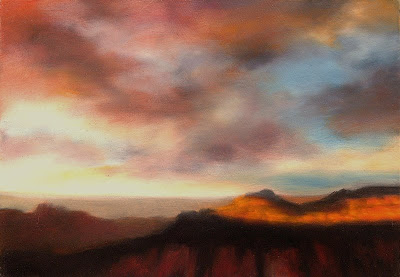
Such aerial views always lend a soaring feeling of freedom, and power. Transformations of color in the sky, along with monumental mountains instill respect for nature, but also a kind of kinship, of participation in grand changes; the power and grandeur of nature passes on to the viewer. The contrast between blue and orange hues imparts a nostalgic yearning; emphasized by constant color transition as it occurs in real life, the sense of movement is achieved here by the seeming randomness of paint distribution. This is one of the reasons why we love watching sunsets: every change on such a large scale finds a small echo in our private lives. The formula is simple: we compensate for the difference with an emotional response, and hence the nostalgia.
When I first glanced at this painting, I immediately started imagining myself moving around and inspecting the canyon from a high position. The mysterious stripe of orange seems so tempting: “come closer and look at me…” It remained to determine the kind of apparatus I would use, and I picked a hang-glider. No motor noises; rather, a bird-like maneuvering ability, with the wind blowing right in my face, supporting the wings of my flying machine. It makes sense to entrust oneself to the forces of nature when wanting to pay a tribute and marvel at it — if only in one’s fancy. This piece, though representing a single point in time, accumulates a capacity for projecting a temporal progression, largely due to its saturnine lyricism, ensuing, once again, from the blue, white and orange contrasts.
When two elements comprise a landscape — air and earth in this case — it is interesting to study the relationship between the two. Do they cooperate in some way, or do they struggle, and fight for supremacy? Here, it seems, the first example qualifies. It is as though the sky invests in the earth, practically all it has — the intense and epic palette gradually flows downward, inside the canyon — a safe that concentrates the wealth of color. The clouds form a triangle that points towards the canyon. In turn, the ridges point towards the vertex of that triangle. Together, they appear to be communicating, striving to reach an “understanding,” a kind of a common ground. In pictorial terms, this understanding translates into harmony and unity.
There is enough light to oppose the general gloomy atmosphere: it partially negates the darker tones, and reminds of their temporariness. Though the white occupies a relatively small area on the canvas, its concentration makes up for it. The energy matters no less than the territory: just consider the Big Bang theory, with the whole universe expanding from one singular point. The light enlivens this piece, or rather prepares to do so when the time is right, in a few more hours, lurking between the skyline and the clouds. It adds a touch of day to the coming night, varying even more the palette and its effects. Or, perhaps, to the parting night, as it seems that the artist leaves it open for interpretation.